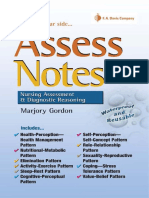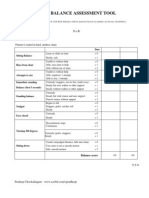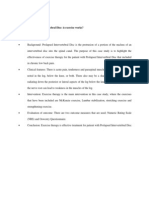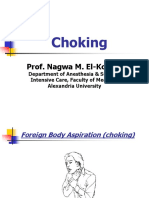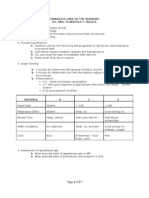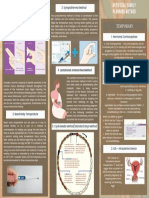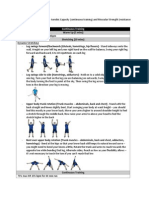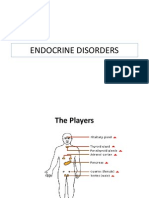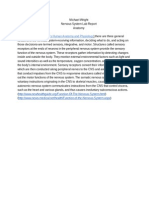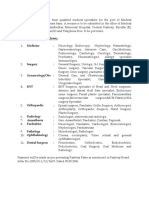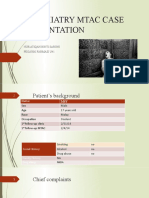Passive ROM
Passive ROM
Uploaded by
Czarina FayeCopyright:
Available Formats
Passive ROM
Passive ROM
Uploaded by
Czarina FayeOriginal Description:
Copyright
Available Formats
Share this document
Did you find this document useful?
Is this content inappropriate?
Copyright:
Available Formats
Passive ROM
Passive ROM
Uploaded by
Czarina FayeCopyright:
Available Formats
LEARNING CONTENT
PASSIVE RANGE OF MOTION
WHAT IS PASSIVE ROM?
Passive range of motion exercises helps keep a person's joints flexible, even if he cannot
move by himself. Range of motion is how far the person's joints can be moved in different
directions. The exercises help you move all the person's joints through their full range of motion.
WHY SHOULD YOU DO IT?
Range of motion exercises are very important if patient have to stay in bed or in a
wheelchair. Range of motion exercises help keep joints and muscles as healthy as possible.
Without these exercises, blood flow and flexibility (moving and bending) of joints can decrease.
Joints, such as knees and elbows, could become stiff and locked without range of motion
exercises.
HOW TO PERFORM IT?
UPPER EXTERMITIES
1. Head and Neck exercises
a. Chin-to-chest.
- Raise the back of the person's head up frange of motion the bed. Gently tip his chin
toward his chest. Try to rest the person's chin on his chest if possible.
b. Head turns.
- Put one hand on each side of the person's face. Turn the person's head toward the
right as if he were looking over his right shoulder. Then slowly turn the person's
head so he is looking over his left shoulder. Turn the head only far enough so that
the person's nose is lined up above their shoulder.
c. Head tilts.
- Put one of your hands on each side of the person's face. Tilt the head to the side,
bringing the right ear toward the right shoulder. Then slowly tilt the person's head
to bring the left ear toward the left shoulder.
2. Elbow Flexion and Extension
- Hold the upper arm with one hand and forearm with the other hand. Bend the arm at
the elbow so that the hand touches the shoulder. Then straighten the arm all the way
out.
3. Shoulder Flexion and Extension
- Hold the wrist with one hand. With the other hand, grasp the elbow joint to stabilize it.
Turn the palm inward, facing the body, and keep the elbow relatively straight. Move the
arm from the side of the body over the head.
4. Shoulder Internal and External Rotation
- Place one hand under the elbow. With your other hand, hold the forearm. Bring arm out
to the side to shoulder level. Turn arm so that the hand points to the ceiling. Then turn
arm back down so that hand points to floor and the upper arm is twisting in the
shoulder joint.
5. Forearm and Wrist exercises
a. Wrist rotation.
- Hold the wrist and hand of the right arm with the palm face down. Keeping his elbow on
the bed, lift the forearm up. Hold the hand and bend it back toward the wrist. Then
bend the hand down only until you feel resistance. Rock the hand back and forth
sideways. Gently rotate the hand in smooth circles.
b. Palm up, palm down.
- Keep the person's elbow and forearm on the bed and raise his hand. Gently twist it so
his palm is up. Then twist it so his palm is down.
Repeat the above exercises with the left arm.
c. Finger spreads.
- Gently straighten out his fingers. Spread the fingers wide apart, one at a time. Then
bring the fingers back together.
d. Finger-to-thumb touches.
- One at a time, bring each fingertip to touch the thumb.
6. Hip and Knee exercises: Do each exercise 10 to 15 times.
- Place the person's right leg flat on the bed. Put one hand under the ankle and your
other hand under the knee. Straighten the leg and return it to a flat position on the bed
after each exercise. Hip and knee bends.
- Slowly bend the hip and knee up toward the chest as much as possible. Slide your hand
out from under the knee and toward the upper thigh (leg). Do this to help the knee
bend completely.
a. Leg movement, side to side.
- Move the right leg out to the right side as far as possible. Then return the leg to the
middle and cross it over the left leg.
b. Knee rotation, in and out.
Bend the person's knee so the bottom of the right foot is flat on the bed. Roll the leg
inward as far as possible. Try to touch the bed with the big toe. Roll the leg outward as
far as possible. Try to touch the bed with the small toe.
Repeat the above exercises with the left leg.
7. Ankle and Foot exercises: Do each exercise 10 to 15 times. How to start:
- Hold the right ankle with one hand. Put your other hand on the bottom of the foot.
Ankle bends.
- Push the person's foot so his toes point up toward the ceiling. Then put your hand on
top of the foot and push the foot down again.
a. Ankle rotation.
- Hold the ankle with one hand. Hold the person's upper foot with your other hand.
Gently turn the foot and ankle in circles.
b. Toe bends.
- With your palm on top of the person's foot, curl the toes down toward the sole (bottom)
of the foot. Then straighten and stretch the toes.
c. Toe spreads.
- Use your fingers to spread the toes apart one at a time. Then bring them together
again.
REFERENCES:
Passive range of motion (PROM) exercises to improve joint movement. (n.d.). Retrieved from
Family Health: http://www.family-friendly-fun.com/family-health/therapy/passive-rangemotion.htm
Truven Health Analytics Incorporation. (2015). Passive Range Of Motion Exercises. Retrieved from
Drugs.com: https://www.drugs.com/cg/passive-range-of-motion-exercises.html
You might also like
- 13 585a PDFDocument2 pages13 585a PDFtomeytto100% (1)
- Ibs (Conceptmap)Document4 pagesIbs (Conceptmap)Carly Beth Caparida LangerasNo ratings yet
- Physical Assessment Write-UpDocument10 pagesPhysical Assessment Write-UpkathypinzonNo ratings yet
- Knee Replace Care PlanDocument11 pagesKnee Replace Care PlanLaura Romness100% (2)
- Shoulder Case Study 1Document4 pagesShoulder Case Study 1superhoofy718667% (3)
- Vestibular Rehabilitation: Gaze Stabilization VOR x2Document1 pageVestibular Rehabilitation: Gaze Stabilization VOR x2Curt YunkNo ratings yet
- Assess Notes Nursing AssessmentDocument206 pagesAssess Notes Nursing Assessmenttostc100% (7)
- Dental Caries SeminarDocument119 pagesDental Caries SeminarManva Monish88% (8)
- Juvenile Rheumatoid ArthritisDocument3 pagesJuvenile Rheumatoid ArthritisYnos Sta TeresaNo ratings yet
- Vendivel IE SampleDocument12 pagesVendivel IE SampleMargareth Christine CusoNo ratings yet
- Manual TherapyDocument16 pagesManual TherapylecturioNo ratings yet
- Head To Toe AssesmentDocument4 pagesHead To Toe AssesmentYemaya84100% (1)
- Advice For Patients With A Fractured Wrist in A Plaster CastDocument4 pagesAdvice For Patients With A Fractured Wrist in A Plaster Castmohit bansalNo ratings yet
- Abbreviations Used in DocumentationDocument6 pagesAbbreviations Used in DocumentationHydra Olivar - PantilganNo ratings yet
- Case Study Cerebrovascular Accident TRIXIEDocument10 pagesCase Study Cerebrovascular Accident TRIXIETrixie Marie Shebel AbdullaNo ratings yet
- Managing Lumbar Spinal StenosisDocument11 pagesManaging Lumbar Spinal StenosismudassarnatiNo ratings yet
- Hip Replacement GuideDocument28 pagesHip Replacement GuideZulaika NaisNo ratings yet
- Osteoarthritis in The Geriatric Population 1Document7 pagesOsteoarthritis in The Geriatric Population 1api-532703094100% (1)
- Tinitti Balance Assessment ToolDocument2 pagesTinitti Balance Assessment Toolcpradheep100% (2)
- Diabetic NeuropathyDocument4 pagesDiabetic NeuropathyAsish GeiorgeNo ratings yet
- Bed Sore 2Document4 pagesBed Sore 2Zymmer100% (1)
- Cva Case StudyDocument16 pagesCva Case StudyEricson SomeraNo ratings yet
- GBS Management, Medications and Nursing ConsiderationsDocument4 pagesGBS Management, Medications and Nursing Considerationssouledg3100% (1)
- Case StudyDocument30 pagesCase StudyNur Solehah0% (1)
- ChockingDocument29 pagesChockingNoor A. ZakiNo ratings yet
- Respiratory Assessment FindingsDocument197 pagesRespiratory Assessment Findingsannatw100% (2)
- Range of Motion Exercises: General InstructionsDocument4 pagesRange of Motion Exercises: General InstructionsEma JeffersNo ratings yet
- Ortho AssignmentDocument18 pagesOrtho AssignmentSean Derick Cariño MercadoNo ratings yet
- Hernia CaseDocument9 pagesHernia CaseFatima Love Ariate-Arcasetas100% (1)
- Growth and Development Handouts Docs-1Document17 pagesGrowth and Development Handouts Docs-1Riolonzo JoaquinNo ratings yet
- Exercise and Rehab OldDocument71 pagesExercise and Rehab OldAyyappan JayavelNo ratings yet
- Talipes CalcaneovalgusDocument4 pagesTalipes CalcaneovalgusJayantiNo ratings yet
- Cabuya - Family Planning BrochureDocument1 pageCabuya - Family Planning BrochurelorreaNo ratings yet
- Patient X (Cellulitis Right Arm) : Subjective Data Objective Data Assessment Data Plan Intervention EvaluationDocument1 pagePatient X (Cellulitis Right Arm) : Subjective Data Objective Data Assessment Data Plan Intervention EvaluationJhevilin RMNo ratings yet
- NCM 109-Cerebral PalsyDocument36 pagesNCM 109-Cerebral PalsyLeigh Ann Prosyne Lozada100% (1)
- Interpretation of Arterial Blood Gases and Acid-Base DisordersDocument44 pagesInterpretation of Arterial Blood Gases and Acid-Base DisordersSuren VishvanathNo ratings yet
- LI - Physical Examination - AbdomenDocument6 pagesLI - Physical Examination - AbdomenTravis DonohoNo ratings yet
- MGH Wrist and Elbow Strengthening ExercisesDocument1 pageMGH Wrist and Elbow Strengthening ExercisesRidwan Hadinata Salim100% (1)
- Gait AssessmentDocument3 pagesGait AssessmentÖlvedi Tünde TimeaNo ratings yet
- Shoulderexaminationppt 180505152418Document19 pagesShoulderexaminationppt 180505152418KarthickNo ratings yet
- Mechanical VentilationDocument5 pagesMechanical VentilationCherry Kris Caperig SuarezNo ratings yet
- IsoprenalineDocument2 pagesIsoprenalineImmanuel Victor GeorgeNo ratings yet
- WWW - Qworld.co - in A-Z Disease List For NEETPG: IF Vit B Megaloblastic Anemia)Document5 pagesWWW - Qworld.co - in A-Z Disease List For NEETPG: IF Vit B Megaloblastic Anemia)Qworld100% (1)
- Normal and Abnormal Breath SoundsDocument1 pageNormal and Abnormal Breath SoundsGilwel An Jynamae IrangNo ratings yet
- Lumbar Laminectomy Diskectomy Fusion PDFDocument3 pagesLumbar Laminectomy Diskectomy Fusion PDFRully SyahrizalNo ratings yet
- Physical Assessment 1. General InspectionDocument3 pagesPhysical Assessment 1. General InspectionRijelNo ratings yet
- Multiple Sclerosis: Case Study by Trcoski ElenaDocument43 pagesMultiple Sclerosis: Case Study by Trcoski ElenaElena TrcoskiNo ratings yet
- PT102 - Tilt Table:IPC:Traction - NotesDocument4 pagesPT102 - Tilt Table:IPC:Traction - NotesDeo Sivan PacificoNo ratings yet
- CrutchDocument135 pagesCrutchYahia Tawfeek AlkilanyNo ratings yet
- Caring For Patients With Musculoskeletal DisordersDocument16 pagesCaring For Patients With Musculoskeletal DisorderszebeneNo ratings yet
- Impaired Physical MobilityDocument2 pagesImpaired Physical MobilityHanya Bint PotawanNo ratings yet
- Rom PDFDocument4 pagesRom PDFenzoNo ratings yet
- Crutch WalkingDocument2 pagesCrutch Walkingayisharn100% (1)
- Student Clinical Report SheetDocument2 pagesStudent Clinical Report SheetMike100% (4)
- Ventricular Septal Defect, A Simple Guide To The Condition, Treatment And Related ConditionsFrom EverandVentricular Septal Defect, A Simple Guide To The Condition, Treatment And Related ConditionsNo ratings yet
- COMPREHENSIVE NURSING ACHIEVEMENT TEST (RN): Passbooks Study GuideFrom EverandCOMPREHENSIVE NURSING ACHIEVEMENT TEST (RN): Passbooks Study GuideNo ratings yet
- Acromioclavicular Joint Injury, A Simple Guide To The Condition, Diagnosis, Treatment And Related ConditionsFrom EverandAcromioclavicular Joint Injury, A Simple Guide To The Condition, Diagnosis, Treatment And Related ConditionsNo ratings yet
- 10 Mindful MovementsDocument3 pages10 Mindful MovementsLauroBorba100% (1)
- Identify Types of Exercise For Warm Up and List Out Stretching Exercise Explain Briefly and Include PicturesDocument4 pagesIdentify Types of Exercise For Warm Up and List Out Stretching Exercise Explain Briefly and Include PicturesNikesh MaharjanNo ratings yet
- Vjezbe IstezanjaDocument14 pagesVjezbe Istezanjatn1No ratings yet
- Saturday 28th JuneDocument6 pagesSaturday 28th Juneapi-256828136No ratings yet
- Training Plan Week 4 MondayDocument4 pagesTraining Plan Week 4 Mondayapi-256756581100% (1)
- Bacterial Meningitis: Community AcquiredDocument2 pagesBacterial Meningitis: Community AcquiredCzarina FayeNo ratings yet
- Major Steps in A Quantitative StudyDocument4 pagesMajor Steps in A Quantitative StudyCzarina Faye0% (1)
- Surgical Treatment For Pelvic Organ Prolapse in Elderly WomenDocument4 pagesSurgical Treatment For Pelvic Organ Prolapse in Elderly WomenCzarina FayeNo ratings yet
- Cayetano, P. (2008) - Proclaiming Patient's Rights (2371) - AN ACTPROCLAIMING THEDocument1 pageCayetano, P. (2008) - Proclaiming Patient's Rights (2371) - AN ACTPROCLAIMING THECzarina FayeNo ratings yet
- "E-" + + ( - "Ny") "De-" +: 1. Estrogen DecreasesDocument5 pages"E-" + + ( - "Ny") "De-" +: 1. Estrogen DecreasesCzarina FayeNo ratings yet
- LaminectomyDocument6 pagesLaminectomyPerrilyn Perey100% (1)
- Reynitis AlergicaDocument1 pageReynitis AlergicaCarmen PaolaNo ratings yet
- Pituitary DisordersDocument38 pagesPituitary DisordersJaspreet KangNo ratings yet
- Bhanga 3Document35 pagesBhanga 3Shanmugam PiramanayagamNo ratings yet
- Icd XDocument3 pagesIcd XR Ghianesya GantinaNo ratings yet
- VeinfinderDocument3 pagesVeinfinderশেখমোহাম্মাদসাকাওয়াতআলীNo ratings yet
- Kidney Cancer Case Study FinalDocument6 pagesKidney Cancer Case Study FinalElaine AgustinNo ratings yet
- Nervous System Lab ReportDocument10 pagesNervous System Lab Reportapi-269985211No ratings yet
- Case2CaseMedicalDoctorsDocument2 pagesCase2CaseMedicalDoctorsedkattaNo ratings yet
- PNMCC Directory of StrainsDocument67 pagesPNMCC Directory of StrainsKing James PalmaNo ratings yet
- Evaluation Exam For NCM 101Document4 pagesEvaluation Exam For NCM 101myrna pedidoNo ratings yet
- Indian Army - NCC Special Entry Scheme 35th CourseDocument1 pageIndian Army - NCC Special Entry Scheme 35th CourseCareerNotifications.comNo ratings yet
- Unidades Esterilizadoras, Mediante Plasma Sterrad 100s BrochureDocument2 pagesUnidades Esterilizadoras, Mediante Plasma Sterrad 100s BrochureJair Jesús Cazares RojasNo ratings yet
- Anosh Albert FileDocument4 pagesAnosh Albert FileKeep smileNo ratings yet
- Regen EndoDocument88 pagesRegen EndoJitender ReddyNo ratings yet
- BRS GS Compilation HIGHLIGHTEDDocument108 pagesBRS GS Compilation HIGHLIGHTEDJaney T.No ratings yet
- ConnectorsDocument42 pagesConnectorsfaaljamoohNo ratings yet
- Antibacterial Activity of Seaweed (Caulerpa Lentilifera) and Neem Plant (Azachdiracta Indica) MixtureDocument45 pagesAntibacterial Activity of Seaweed (Caulerpa Lentilifera) and Neem Plant (Azachdiracta Indica) MixtureKATHLEENE JADE FULGENCIONo ratings yet
- A Review of Strategies To Decrease The Duration of Indwelling Urethral Catheters and Potentially Reduce The Incidence of Catheter-Associated Urinary Tract Infections - ProQuestDocument10 pagesA Review of Strategies To Decrease The Duration of Indwelling Urethral Catheters and Potentially Reduce The Incidence of Catheter-Associated Urinary Tract Infections - ProQuestHelmy HanafiNo ratings yet
- Psychiatry Mtac Case Presentation: Nur Atiqah Binti Saroni Pegawai Farmasi U41Document15 pagesPsychiatry Mtac Case Presentation: Nur Atiqah Binti Saroni Pegawai Farmasi U41Khuzairi Bin SudariNo ratings yet
- Eight Steps of Silk BrocadeDocument4 pagesEight Steps of Silk BrocadeRaphael CardanoNo ratings yet
- Final Exam Flashcards - Easy NotecardsDocument41 pagesFinal Exam Flashcards - Easy NotecardsTalo MjNo ratings yet
- Negative Pressure Wound TherapyDocument5 pagesNegative Pressure Wound TherapyarfahNo ratings yet
- TI 1281 AEROSIL and AEROPERL Colloidal Silicon Dioxide For Pharmaceuticals enDocument24 pagesTI 1281 AEROSIL and AEROPERL Colloidal Silicon Dioxide For Pharmaceuticals enChan NovNo ratings yet
- Total Iron-Binding Capacity (TIBC)Document4 pagesTotal Iron-Binding Capacity (TIBC)tuan vănNo ratings yet
- Atorvastatin 0Document7 pagesAtorvastatin 0AgronaSlaughterNo ratings yet
- Accomplishment EincDocument4 pagesAccomplishment EinccharmaineNo ratings yet
- Student's Assessment Form PDFDocument4 pagesStudent's Assessment Form PDFpatriarch_fall100% (2)
- Neurodermatitis (Lichen Simplex Chronic) : ReferatDocument12 pagesNeurodermatitis (Lichen Simplex Chronic) : ReferatJAQUELINENo ratings yet






